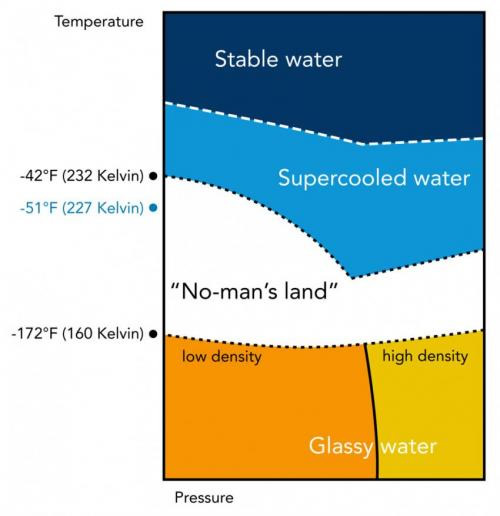
This diagram illustrates the rough boundaries of “no man’s land,”
a temperature region where supercooled water is difficult to study
because of rapid ice formation. Using SLAC’s Linac Coherent Light
Source, scientists dipped down to minus 51 degrees Fahrenheit and made
the first structural measurements of liquid water in this mysterious
region, where water’s unusual properties are amplified.
Quick, how many phases of water are there? If you answer three -
liquid, solid, and gas - you'd be wrong. There are at least
5 distinct phases of liquid water and 15 distinct phases of ice that
scientists know about, as we've told you before in our post 5 Really Weird Things About Water.Now, thanks to some fancy X-ray technology, scientists at the Department of Energy's SLAC National Accelerator Laboratory have probed the structure of liquid water in a certain region of temperature and pressure where things really get weird.
According to SLAC National Accelerator Laboratory:
Despite its simple molecular structure, water has many weird traits: Its solid form is less dense than its liquid form, which is why ice floats; it can absorb a large amount of heat, which is carried long distances by ocean currents and has a profound impact on climate; and its peculiar density profile prevents oceans and lakes from freezing solid all the way to the bottom, allowing fish to survive the winter.Read more about it over at SLAC National Accelerator Laboratory.
These traits are amplified when purified water is supercooled. When water is very pure, with nothing to seed the formation of ice crystals, it can remain liquid at much lower temperatures than normal. The temperature range of water from about minus 42 to minus 172 degrees (see diagram) has been dubbed no man’s land. For decades scientists have sought to better explore what happens to water molecules at temperatures below minus 42 degrees, but they had to rely largely on theory and modeling.
Now the LCLS, with X-ray laser pulses just quadrillionths of a second long, allows researchers to capture rapid-fire snapshots showing the detailed molecular structure of water in this mysterious zone the instant before it freezes. The research showed that water's molecular structure transforms continuously as it enters this realm, and with further cooling the structural changes accelerate more dramatically than theoretical models had predicted.

No comments:
Post a Comment